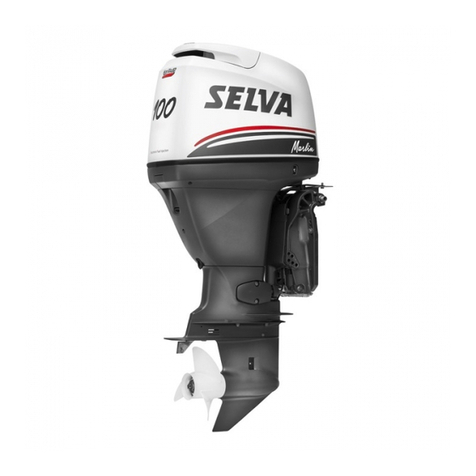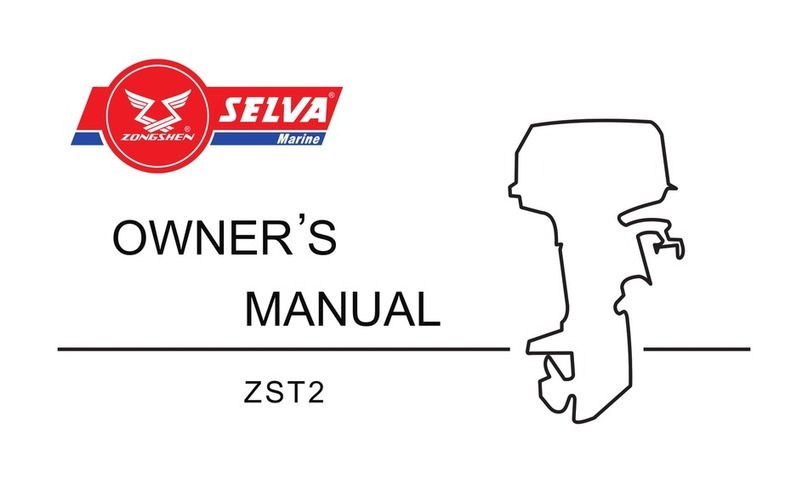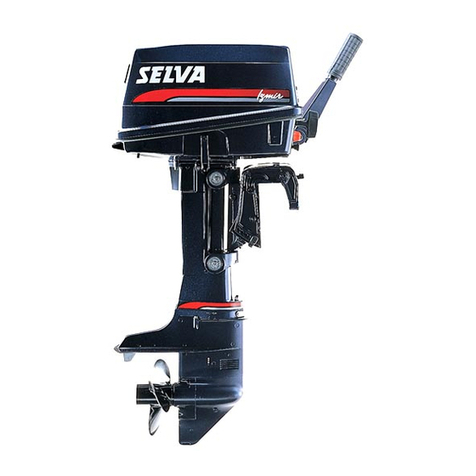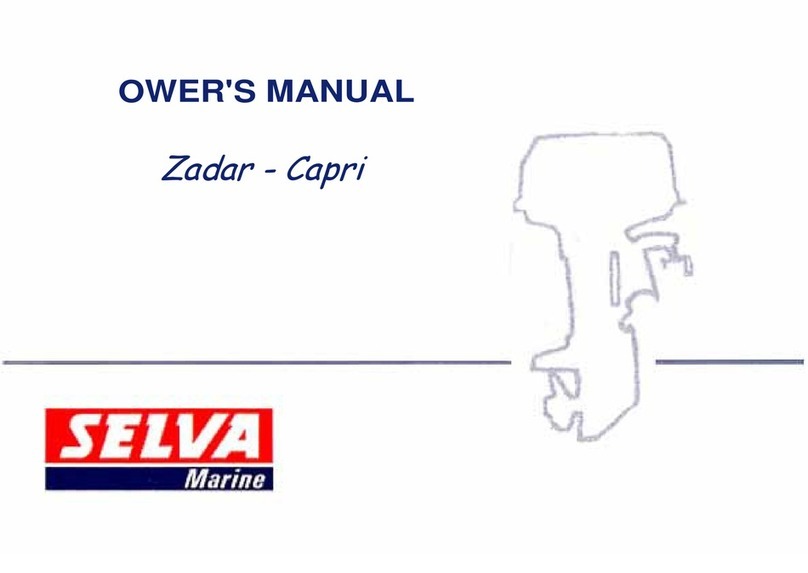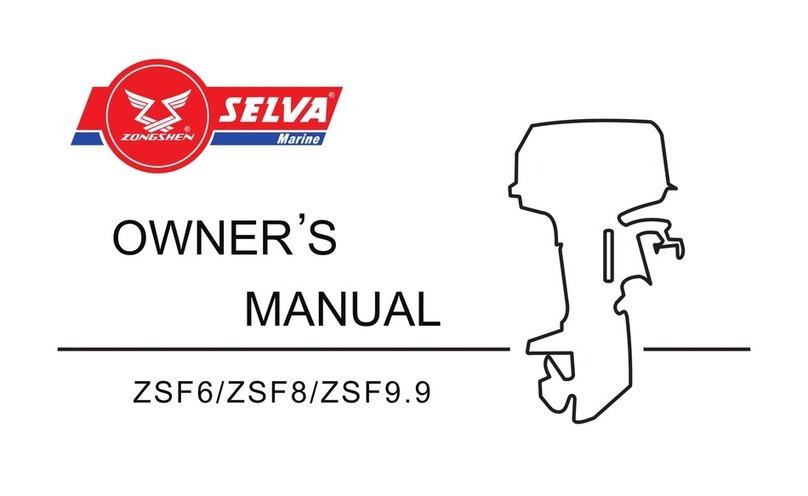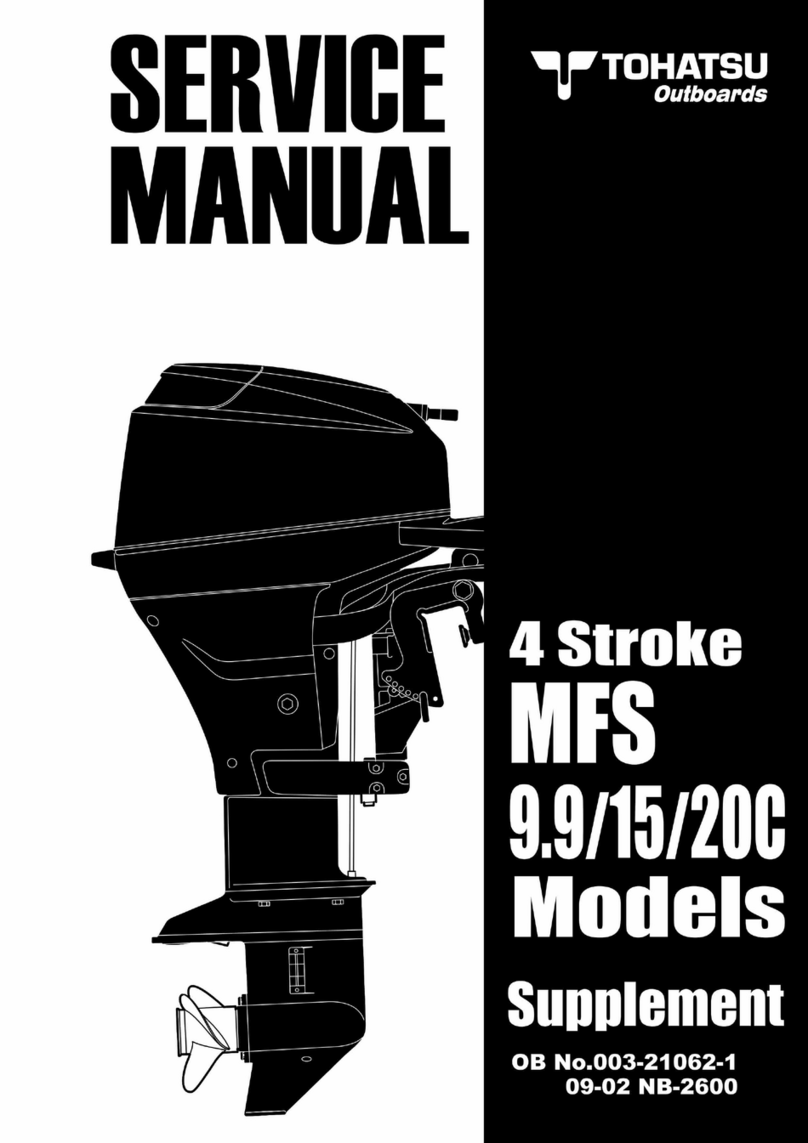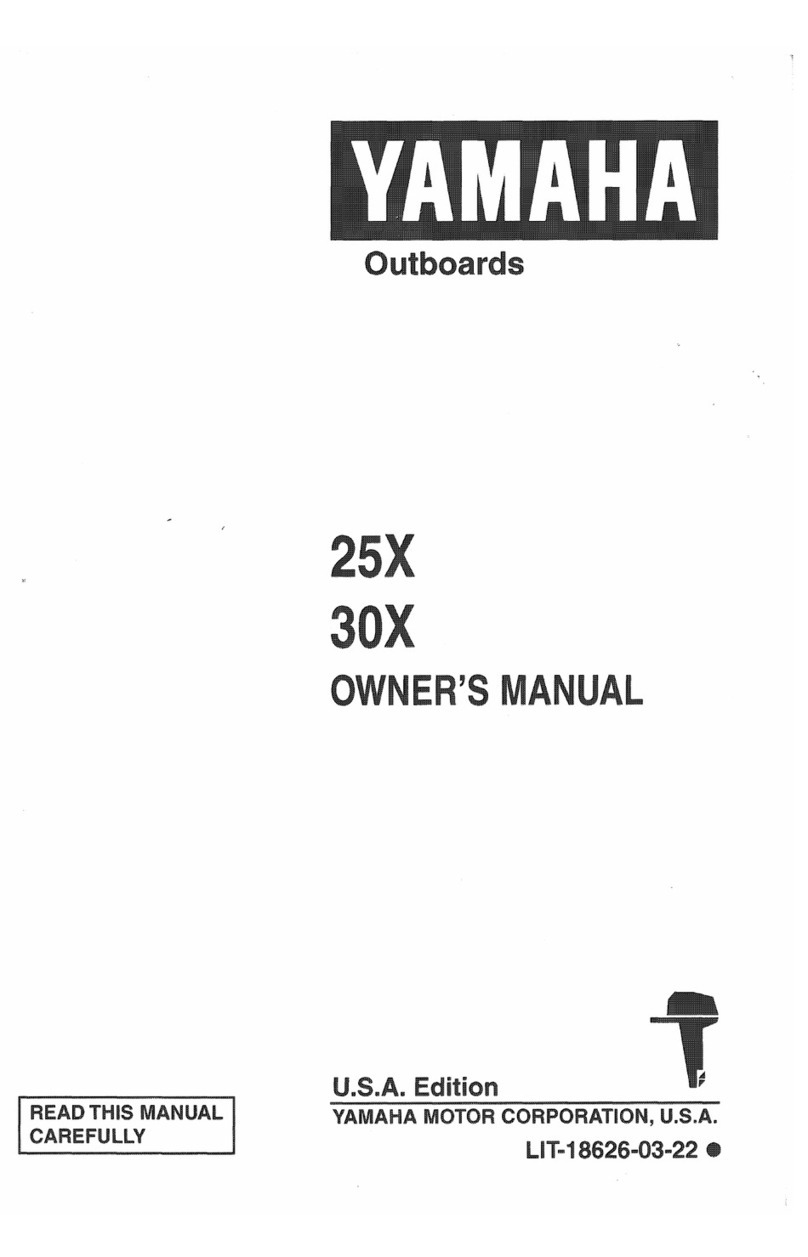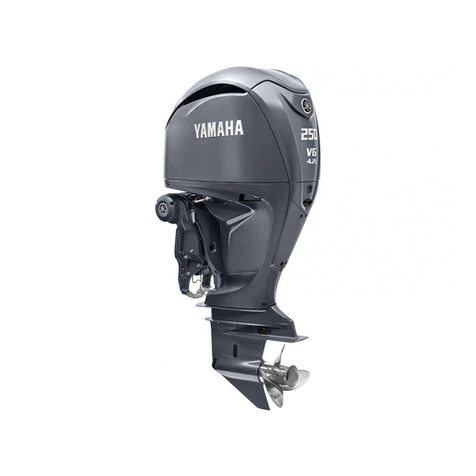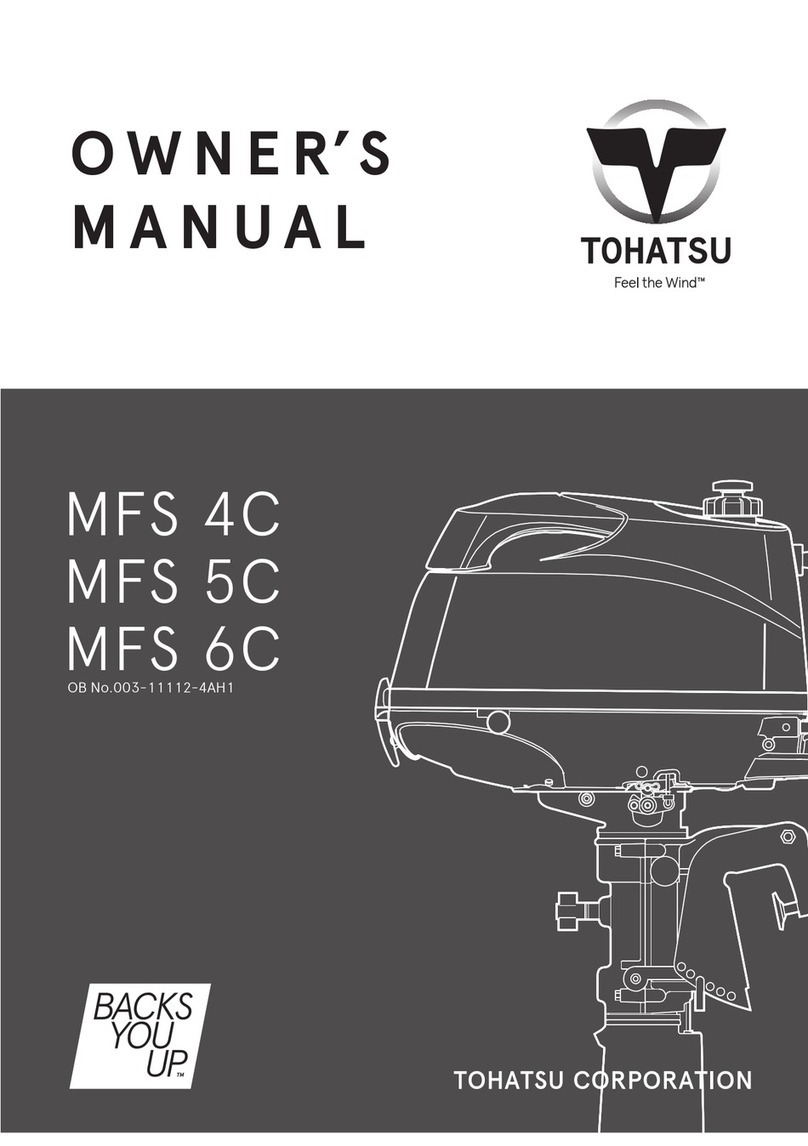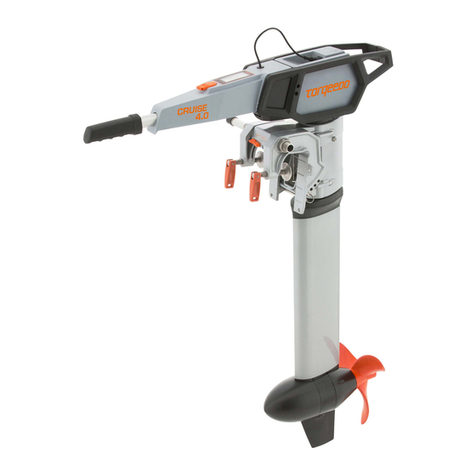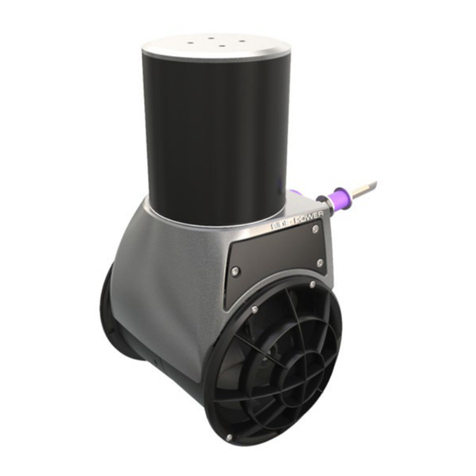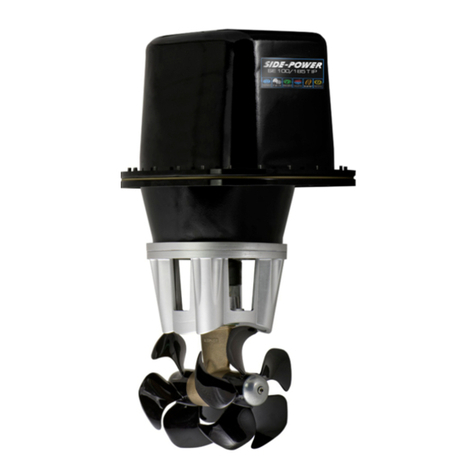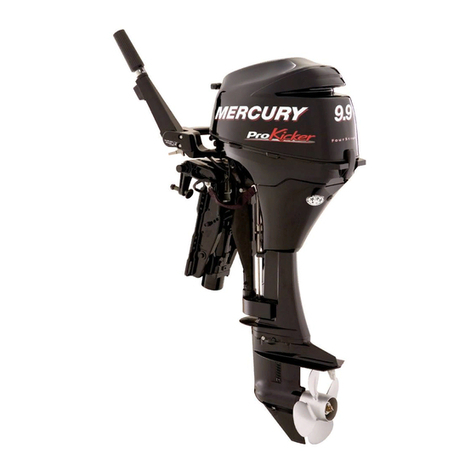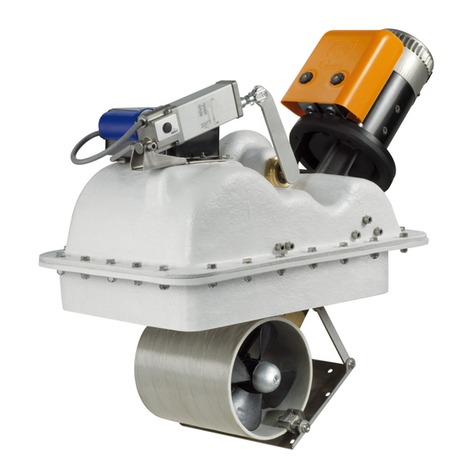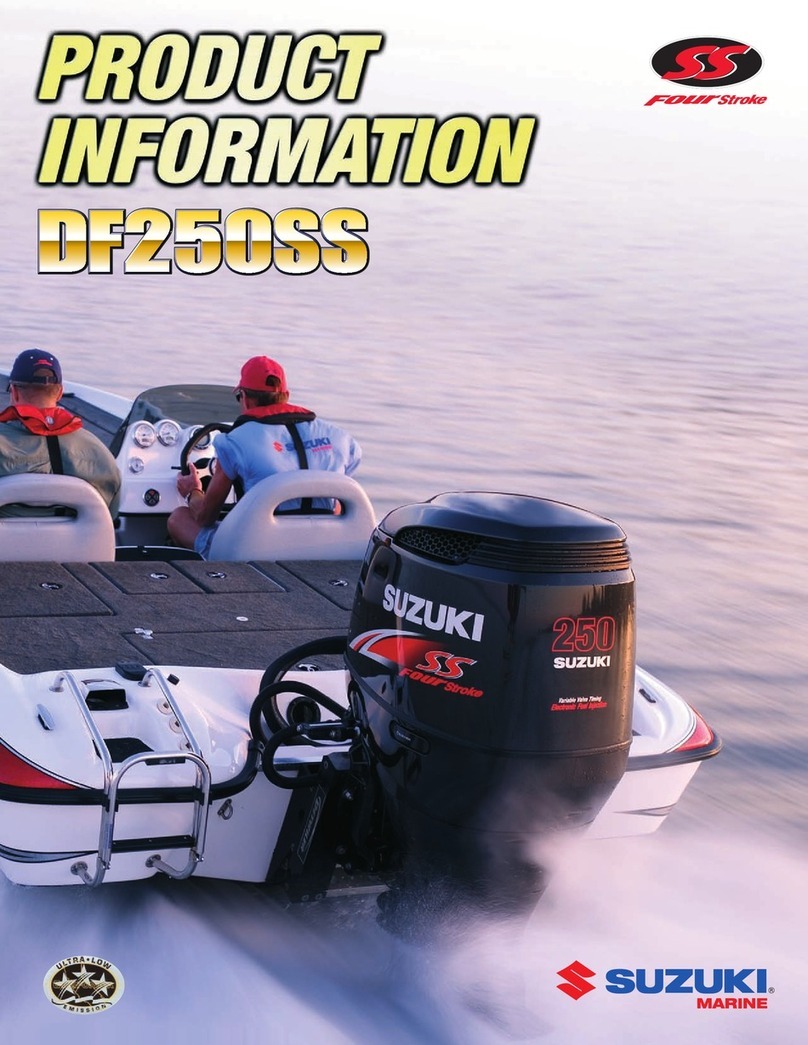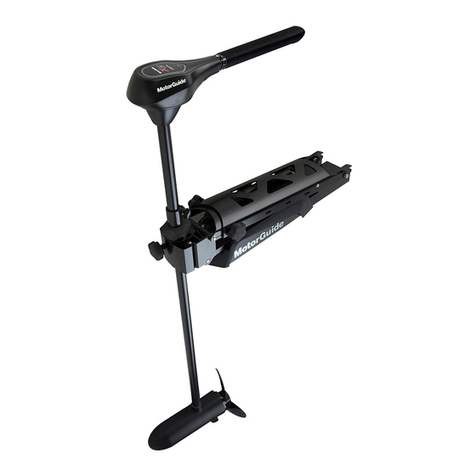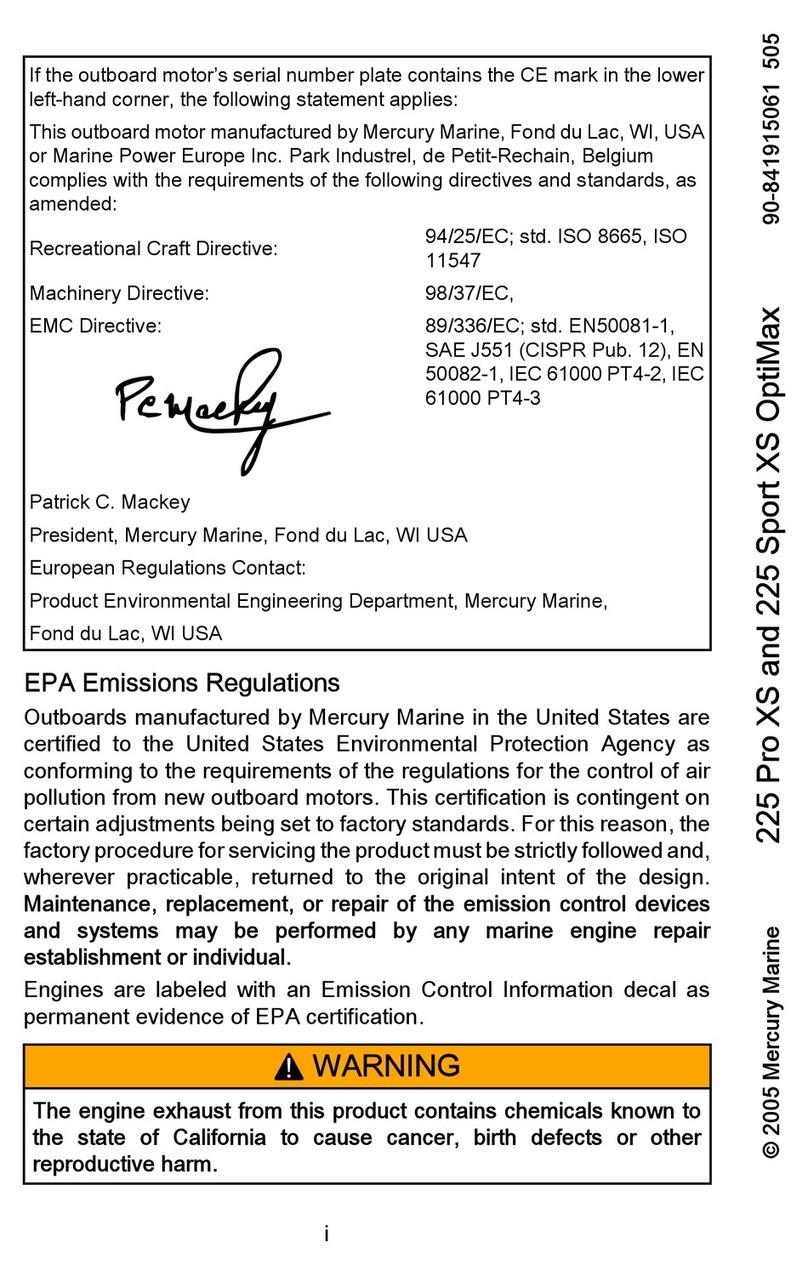Selva Sea Bass 4 User manual

(inglese)
OWNER'S MANUAL
Sea Bass 4
Sea Bass 5
Vers. 01-2012

1
This manual must be considered as an integral part of your outboard motor and has to be kept with it, also if the motor is resold.
Selva joint-stock CO. reserve the right to change its product at any moment, except for the essential specifications, which will be
kept as they are.
Any reference to products or details of a third party has only an informative purpose and it doesn't represent an obligation.
Selva joint-stock CO. doesn't take on any responsibility concerning the performance or the employment of these products.
We are glad that you have chosen a SELVA MARINE product, which means quality, technology and careful research. Your choice
will give you many advantages, which you will soon learn to appreciate. Our dealers, our after-sales service and the guarantee,
which you have signed, together with the observance of the information contained in this owner's manual are the essential
conditions to give your recent purchase a long life.
Your holiday, your favorite sport, your job, which has from today the name SELVA MARINE, will be a further moment of
satisfaction.
This manual belongs to Selva joint-stock CO. All rights reserved. Any partial or total reprinting without the permission is
prohibited.

2
INTRODUCTION
Before operating this outboard motor, read this Owner's Manual
carefully and completely, pay attention especially to the safety
measures and rules.
Your safety and other people's sa fety do not depend only on your
ability at using the motor, but they depend also on your knowledge
and on the efficiency of the motor as well as on the respect of the
laws and regulations relating to the use of outboard motors.
We suggest you improve your kno wledge of the motor so that you
can sail with mastery and confidence.
If any kind of repair on the mo tor should not have been clearly
described in this manual or if y ou want to order spare parts or
accessories, or if you have any question about t he operation or
maintenance of your outboard moto r, please consult an authorized
SELVA MARINE service station or SELVA MARINE dealer
ATTENTION
Pay attention to all the particularly important information that in this
manual are distinguished in the following ways:
Safety measures and rules, which protect the machine
operator and other people from serious accidents or
risks.
Directions or special precautions that must be taken
to avoid damage to the outboard motor or personal
accidents.
Directions that make procedures easier or clearer.
Technical information.

3
OUTBOARD MOTOR IDENTIFICATION DATA
This data is stamped on the label attached on the clamp bracket, as
shown on the picture 1.
When you receive your new SELVA outboard motor write down the
serial number, it will be useful to you in case you will have to order
spare parts or for reference if your outboard motor would be stolen.
Make sure that the data on the label is the same as
the data written in your registration book.
Picture No.1
Do not install an outboard motor with higher
horsepower than shown in the certification of your
boat.
SERIAL NUMBER RECORD
Write down the identification number and the model of your
outboardmotor in the spaces below.
MOTOR MODEL
SERIAL NUMBER

4
CONTENTS
GENERAL INFORMATIONS ..........................................1
Introduction......................................................................2
Outboard motor identifiation data ...................................3
Serial Number record ......................................................3
Directions for use. Basic safety measures ......................5
Specifications ..................................................................8
Location of main components .........................................9
Control functions.............................................................10
Wiring diagram ...............................................................11
Symbols..........................................................................11
THE USE OF OUTBOARD MOTOR..............................12
Preliminary controls chart ..............................................12
Check of the supply........................................................13
Outboard motor mounting ..............................................13
Battery mounting (if installed).........................................14
Trim angle adjusting .......................................................15
Refuelling ......................................................................16
Fuel.................................................................................16
Fuel type.........................................................................16
Fuel tank and pipes connections....................................16
Mixing oil .......................................................................17
Starting ..........................................................................17
Verification before starting the motor .............................17
Starting procedure..........................................................17
Verification when the motor is on ...................................18
Emergency starting procedures .................................19
Running-in procedure.....................................................19
Navigation .....................................................................20
Responsibility during the navigation...............................20
Shallow water cruising.................................................... 20
Reserve fuel (ver. built-in tank) ......................................20
Stopping procedure ..................................................... 21
Emergency stopping procedure .....................................21
Stopping in normal conditions ........................................21
Stopping for a long storage period ................................. 21
Removal of the motor from the boat............................... 21
Cleaning ........................................................................22
Outside cleaning.............................................................22
Cleaning cooling-water passages ..................................22
Maintenance..................................................................22
Introduction..................................................................... 22
Periodic inspection and adjustments chart..................... 23
Greasing chart ...............................................................23
Greasing and additions ..................................................24
Gearbox-oil change........................................................24
Spark plug ......................................................................24
Anodic protection............................................................25
Replacement of the propeller ......................................... 25
Storage........................................................................... 26
TROUBLESHOOTING...................................................26
Troubleshooting chart..................................................... 27
EXPLANATORY PICTURES......................................... 28

5
DIRECTIONS FOR USE
BASIC SAFETY MEASURES
To use the outboard motor you must have all requisites
provided by law (physical suitability, insurance, government
duties, registration, and so on). We suggest you become
familiar with your boat equipped with SELVA motor in places,
which are not too crowded.
Taking some medicines, alcoholic drinks or drugs increase
considerably the risk of accidents.
Make sure that you are in a physical condition suitable for
driving. Pay attention to tiredness and sleepiness.
The engine operator should not let his mind wander, or be
distracted or influenced by other people, things or actions,(do
not smoke, eat, read, and so on.) while steering the boat.
Use fuels and oils suitable for the engine, which are listed in
the "greasing chart ".
Check every so often the oil level and the fuel level.
Stop the motor before every kind of maintenance or cleaning
procedures, and in case of complicated maintenance take the
spark-plug cap out.
Picture No. 2.
When the motor is running it may reach high temperatures.
Before opening the top cowling, wait till the engine has cooled
down.
Do not open the top cowling, when the engine is running.
Picture No. 3.

6
PAY ATTENTION TO THE PROPELLER
The propeller is certainly the less protected part of your motor.
It is therefore forbidden to get near the propeller when this is in
rotating. You must leave bathers, skiers and other boat users
enough space to move, in order to avoid any contact with the
propeller.
Picture No. 4.
The engine operator must attach the engine stop switch
lanyard to his wrist when the motor is on.
Picture No. 5.
Never sit on the motor Picture No. 6.
Never change the trim/tilt angle of your motor pushing on the
steering handle.
Picture No. 7.
The motor must always have its top cowling on, when it is
operating
Picture No. 8.
When you connect the fuel joint, check the proper connection.
Picture No. 9.
When starting there must be nobody within the engine
operator's action radius. Picture No. 10.
There must be nobody within the motor steering radius.
Picture No. 11.
The free lock lever must always be engaged while the motor is
in motion.
Never tilt-up the motor out of the water, while it is in motion.
Picture No. 12
Never pull the recoil starter handle, while the motor is running.
Picture No. 13.
To transport the motor use only the proper handle.
Before transporting the motor you have to tilt-up the steering
rod properly.
The fuel tank is also provided with a handle to use for the
transport. Picture No. 14.
When starting or operating the engine, do not touch electrical
parts and particularly the ignition-coil, the high voltage wire, the
spark-plug cap and the spark-plug itself.
When opening the safety valve of the fuel tank, highly
flammable vapours come out. Do not smoke, inhale or use
open flames close to it.

7
If the motor has had an accident, you should have it fully
checked, before you use it again. If necessary let the SELVA
MARINE authorised skilled staff have a look at it.
Do not use the motor, as the damage could have compromised
the sailing safety.
Any alteration attempted on your motor or the removal of any
of its basic elements, can compromise its safety and besides it
is against the law. It also means the immediate loss of your
guarantee.
Observe the laws in force.
Pay utmost attention to the weather conditions. Listen to the
weather forecast and take the warnings to the sailors into
consideration.
Keep your boat and equipment on board in a perfect state of
efficiency.
Keep enough spare parts on board.
Inform somebody of your route, before sailing.
Prevent fires and explosions..
Before operating an outboard motor, you must know the laws
and regulations relating to navigation.
Avoid sudden and dangerous manoeuvres
SELVA motors are only meant as propulsion for pleasure craft.
SELVA joint-stock CO. declines all responsibility for any
damage to items or harm done to any person, which is due to
an improper use of the motor.

8
SPECIFICATIONS
MODEL Sea Bass 4 – F118A Sea Bass 5 – F118A
POWER 4 HP/2,9 Kw 5 HP/3,7 Kw
FULL THROTTLE OPERATING RANGE 5000/6000 5500/6000
PISTON DISPLACEMENT
118 118
BORE X STROKE
56x48 56x48
NUMBER OF CYLINDER
1
ENGINE TYPE cycle eight - 4 stroke
FUEL PUMP N° 1 Mechanical pump
AVERAGE CONSUMPTION 1,1 litres/hour 1,3 litres/hour
FUEL Petrol min 95 octans RON
FUEL TANK Separatated lt 12 ( Incorporated lt. 1,6 )
OIL TANK Incorporated cc. 700
RECOMMENDED ENGINE-OIL NMMA TC-W3 – SAE J 1536 GRADE 3
(OIL FOR MIXTURE 2 STROKES SYNTHETIC)
IGNITION Digital CDI
SPARK LEAD electronic automatic programmed with the engine revolutions
STARTING manual with rope, which returns automatically on the pulley
SPARK PLUGS
NGK DCPR6E
EXHAUST submarine depression-working through the propeller-hub
COOLING water cooling with forced circulation caused by a pump
PROPELLER REDUCTION RATIO 13/30
GEAR SHIFT LEVER
forward gear - neutral gear - reverse gear(shaft rotation of 360°)
RECOMMENDED GEARBOX-OIL OUTBOARD MOTOR GEARBOX OIL API GL-5 SAE 80W/90
GEARBOX-OIL QUANTITY 220cc / 200 gr
PROPELLER TYPE
anti-weed with three blades with silent-block incorporated
TRIM ANGLE ADJUSTING
4 positions, which you can select through pin
SUSPENSIONS anti vibrations annular shock-absorbers
RECOMMENDED HEIGHT OF
THE TRANSOMS(mm.)
Normal shaft 380 – Long shaft 510
WEIGHT (Kg.) Normal shaft 23 – Long shaft 23,5
Selva joint-stock CO reserve the right to change weight, construction, materials and characteristics without warning and without therefore having to change
the motors, which were built previously. See Picture No. 15 for the dimensions of your motor.

9
LOCATION OF MAIN COMPONENTS See picture No.16
N° DESCRIPTION
1 Lubricating oil tank cap (2 stroke oil)
2 Security stop / stop switch
3 Accelerator clutch
4 Acceleration grip
5 Tilt-up handle and air intake
6 Transport handle
7 Steering wheel adjustment
8 Swivel bracket
9 Trim adjustment pin
10 Anode
11 Anti-cavitation plate
12 Engine cooling water inlets
13 Propeller nut
14 Propeller
15 Engine oil drain plug
16 Hole for the engine cleaning joint plug
17 Oil-level plug hole
18 Clamp-screws
19 Security stop rope
20 Front cowling lock lever
21 Choke knob
22 Fuel connector
23 Tilt-up lever
24 Fuel grip (Models with incorporated tank)
25 Gear-shift lever ( R = reverse gear ; N = neutral gear ; F = forward gear)
26 Water circulation warning lamp
27 Starter handle
28 Fuel tank cap (Model with built-in fuel tank only)

10
CONTROL FUNCTIONS
Gear-shift lever .
Starting out from the position of neutral gear ( N ), turn the
lever in boat direction (F) and you engage the clutch with the
forward gear. Turning it in the opposite direction, you engage
the reverse gear (R).Fig. 17.
Push-button to stop the motor.
Pressing the stop button (red) the ignition circuit is broken and
the engine stops immediately. Fig. 18.
Choke knob.
Pulling out this knob provides a richer mixture which is
required to start a cold engine.
Fig. 19.
Fuel cock. (Integrated tank)
Ruotando il rubinetto si apre o si chiude il passaggio della benzina
verso il carburatore.
Fig. 20.
Fuel joint. (Separated tank)
Turning the cock you open or close the fuel connection to the
carburator.
Fig. 21.
Recoil starter handle. (Model with manual start)
Pulling this handle starts the engine.
Fig. 22.
Emergency engine stop switch.
Switch to stop the engine in an emergency.
Fig. 23.
Throttle-control adjustment.
A device that allows the throttle to be fixed to give a constant
speed.
Fig. 24.
Accelerator-grip/steering-handle.
Turn the grip to operate the accelerator, and move it sideways to adjust
the steering angle.
Fig. 25.
Cowling lock lever.
Cowling locking device. To remove the top cowling pull the
lever upwards. When replacing the cowl, ensure that it is
correctly fitted over the tray and that the front hook is inserted
correctly, locate the rear locking lever over the cowl’s hook and
push down to lock in place.
Fig. 26.
Free-lock lever to control the tilting arrangement.
This lever controls/locks the engine’s tilting hook assembly to
prevent the engine tilting when in reverse gear due to the
propeller thrust.
Fig. 27.
Clamp-screws.
Use them to clamp the outboard motor on the transom.
Fig. 28.
Steering adjustment grip.
With it you can adjust the resistance to steering movement.
Screw it to increase resistance.
Fig. 29.
Shallow water lever.

11
It’s used to release the tilt support bar.
Fig. 30.
Trim angle adjusting-rod.
It can be positioned in different holes in order to obtain the
appropriate trim angle.
Fig. 31.
Wiring diagram Fig. 32.
Legenda
1. Flywheel
2. Ignition-coil
3. Sparking plug.
4. Emergency engine stop switch / Stop button
Wiring colour scheme
Red = Re
Black = Ba
Blue = Bu
Brown = Br
Black / Light blue = Ba / Az
Light blue = Az
Grey = Gr
Orange = Or
White = Wh
SYMBOLS Fig.
33.
1 - A serious risk is present. The machine operator must
read and follow the instructions in the manual.
2 - Pull the choke knob.
3 - Position of the gear-shift lever.
4 - Outboard motor free lock.
5 - Opening level of the throttle.
6 - Warning against fire hazard.
7 - Button to stop the motor.
8 - Indication fuel cock positionning.

12
USE OF OUTBOARD MOTOR
PRELIMINARY CONTROLS CHART
DETAIL
CHECK DESCRIPTION
PAGE
Complete supply Check that the motor supply includes all the components, that are in the
detailed list. 14
Proper installation
Check the proper installation of your motor (the centre of the transom). 14
Check the proper mounting height of your motor. 14
Check the tightness of the clamp screws. 14
Fuel hose connection Check the proper connection of the fuel hose. 16
Oil filling Check the conformity of the fuel and of the oil to the detailed list. 16-17
Fuel tank Check the position of the fuel tank from detailed list. 16
Check of the equipment on
board
Check that you have on board everything necessary to face a possible
emergency.
Before leaving always check your motor to make sure that
it is in a perfect state of efficiency, check its proper and
safe functionality. Failure to check as shown in the chart
could result in severe injury to people or damage to the
boat.
If you ever have a question about the operation of your
outboard motor, or if you should find any kind of
anomaly, please consult a SELVA MARINE dealer. The
time which is needed to check your motor is very
modest, but the safety, that you obtain from it is
enormous

13
CHECK OF THE SUPPLY
When you receive your motor, check that:
- the packing is integral
- the supply corresponds to the detailed list:
1. The entire motor.
2. Fuel tank supplied complete with the fuel hose and fast
fuel joint ( for the motors with separate fuel tank ).
3. Tool-bag.
4. Use and maintenance manual.
5. Certificate of warranty.
6. Declaration of conformity E.E.C.
- Check that there is no evidence of damage. If there is any
damage or if parts are missing , you must inform immediately
and in detail the forwarding- agent, SELVA joint-stock CO. or
its area agents.
Fig. 34.
OUTBOARD MOTOR INSTALLATION
A good position of the motor on the transom is very
important to have an appropriate trim angle and
therefore to obtain a good performance from your
boat.
To have the optimum mounting height of the
outboard motor, you must mount it so that the anticavitation
plate is between the bottom of the boat
and a level of 2 cm below it and it is parallel to it.
If the mounting-height is too high, cavitation tends to
occur and consequently there will be a falling-off in
the performance and a probable overheating of the
motor.
If the mounting-height is too low, the waterresistance
will increase and thereby reduce engine efficiency.
Fig. 35.
The motor must be vertical to the water surface and
the bracket mounted on a flat even surface and
should be fully supported by the top edge of the
transom.
If the bracket is not fully supported or, if the transom
height is too low, a hard wood block should be
securely fitted between the bracket and the transom. Fig. 36.

14
BATTERY MOUNTING (if installed)
Connecting the battery
Before connecting or disconnecting the battery
leads remove the emergency cut-off, to avoid risks
of electric shock, fire or explosion.
Together with the battery it is important to install with the
battery disconnect switch. (not included)
Mount the battery in a dry, well-ventilated, vibrationfree
location in the boat.
Recommended battery type: 12V 40 AH (144 kC)
Connect the red lead to the positive terminal (+) first; then
connect the black lead to the negative terminal (-).
1. Red lead
2. Black lead
3. Battery
4. Battery disconnect switch Fig. 37.
To disconnect the battery, disconnect the black lead first.
Battery electrolytic fluid is dangerous; it contains
dilute sulphuric acid and therefore is poisonous and highly caustic
Always follow these preventive measures: caustico. Always
follow these preventive measures:
- Avoid bodily contact with electrolytic fluid as it can cause
severe burns or permanent eye injury.
- Use protective eyewear when handling or working near
batteries.
- If any battery electrolytic fluid spills onto your skin, flush
with water.
- If you should get battery electrolytic fluid in your eyes
flush with water for 15 minutes and get immediate medical
attention.
- If you should swallow battery electrolytic fluid, drink large
quantities of water or milk followed by milk of magnesia,
beaten eggs or vegetable milk. Get immediate medical
attention.
Batteries also generate explosive hydrogen gas. Therefore
avoid operating in areas which are not well-ventilated or near
fire, spark, or open flames. DO NOT SMOKE when charging or
handling batteries.
KEEP BATTERIES AND ELECTROLYTIC FLUID OUT OF
REACH OF CHILDREN.

15
TRIM ANGLE ADJUSTING
The trim angle is the inclination angle, that should be given to
the motor in order to obtain an optimal performance from your
boat.
An improper trim angle does not only affect the
performance of your boat, but can also cause loss of
control, which means danger for the people on
board.
While sailing the motor should be perpendicular to
the water surface, but the trim angle can be 3
degrees to 5 degrees.
If the trim angle is made too great, the buoyancy
centre of the boat will shift towards the stern. In this
condition, and if the stability moment at the bow is
large, the boat will tend to "porpoise". If the trim
angle is insufficient, the bow may "plough", making
the boat unstable.
When the boat is in stable trim it remains parallel to
the water.
To adjust the trim angle proceed as follows:
- close the fuel grip (for motors with
built in fuel tank );
- disconnect the free-lock lever and tilt up the motor
- remove the adjusting-rod and reposition the rod in the
desired hole, which allows the appropriate trim angle;
- unlock the tilt support bar and bring again the motor in
the vertical position, so that it leans on the adjustment
pin;
- set the free-lock lever to the lock position.
Improperly distributed load on boat or in different
positions, can alter the ideal trim conditions.
You must adjust the trim angle when the engine is
switched off. Fig. 38.
Ensure the transom clamp screws are tightened
securely
Fig. 39.

16
FUEL
Fuel
The fuel used for the propulsion of internal
combustion engines is highly flammable and, in
certain cases can become explosive.
Refuelling and maintenance operations must be
done in a well-ventilated area and with the engine
stopped.
Do not smoke while refuelling, keep away from
sparks, flames, or other sources of ignition, which
could cause fire or explosion.
Do not spill gasoline. If gasoline spills, wipe it
immediately with dry rags, before starting the motor .
Do not overfill the fuel tank, because gasoline
expands with the heat and the sun radiation.
Tighten the filler cap securely after refuelling.
Do not let gasoline get into your eyes or onto your
skin. Avoid swallowing gasoline or inhaling its
vapour.
Do not pour fuel off using a pipe.
KEEP OUT OF CHILDREN REACH
Gasoline type
Use only petrol with a octane number of 95
N.O. Research or higher and which does not contain alcohol.
(see the detailed list)
Fuel tank clamping and pipes connection
Put the fuel tank horizontally in the hull, anchored to the
bottom, in a place where it does not hinder your movements
and so that the piping is long enough to reach the motor.
Then connect the piping to the fuel joint. Fig. 40.
For this operation you have to insert the female fast fuel joint.
Fig. 41.
Now you have to check the connection, pulling lightly the joint
(do not pull grasping the hose). Fig. 42.
To release it is enough to pull the ring nut of the fast joint.

17
Oil mixture
Even if a 4 stroke, the motor is lubricated with oil for 2 strokes that
is mixed automatically to the gasoline and consumed when it is
used.
Even if the oil autonomy is remarkable, be always
sure of having in the tank a sufficient oil quantity.
For the oil mixture refuelling see the following steps. All refuelling
and maintenance operations must be carried out when engine is
switched off.
• Remove the top cowling from the motor.
• Open the oil filler cap (the smaller tank) and use 2 stroke
oil as per below mentioned specifications.
Fig. 43
Use synthetic oil mixture for 2 stroke motors
Type NMMA TC-W3 – SAE J 1536 GRADE 3
IF MOTOR IS RUNNING WITHOUT OIL, IT MAY
UNDERGO TO SEVERE DAMAGE.
Check that the oil used has the requested specifications
STARTING
Verifications before starting the motor
Check that the top cowling is locked, that the freelock
mechanism is in the lock position and that the
gear-shift lever is in the neutral position ( N ). Fig. 44.
Make sure that the lanyard’s lock plate is installed on the engine
stop switch. Fig. 45.
Start-in-gear protection device
All versions are equipped with mechanical or electrical devices
that prevent the engine starting in gear.
Starting procedures for motors with built in fuel tank:
1. Open the fuel cock. If the engine is cold, pull out the choke
knob. Fig. 46.
2. Place the throttle-grip in the "start" position. Fig. 49.
3. Pull the starter-handle slowly so that the starter pinion
engages with the flywheel. Fig. 50.
4. Pull the starter-handle powerfully until the engine starts.
If necessary, repeat the procedure. Fig. 51.
5. Let the engine run for a few seconds, then press the choke
control rod. Fig. 52.

18
Starting procedures for motors with separatated fuel tank
1. Loosen the air vent valve on the fuel tank filler cap. Fig. 47.
2. Fill up the carburettor with fuel using the priming bulb in the
fuel line. Keep pressing the priming bulb until it becomes
firm. If the engine is cold, pull out the choke knob. Fig. 48.
3. Place the throttle-grip in the "start" position. Fig. 49.
4. Pull the starter-handle slowly so that the starter pinion
engages with the flywheel. Fig. 50.
5. Pull the starter-handle powerfully until the engine starts. If
necessary, repeat the procedure. Fig.
51.
6. Let the engine run for a few seconds, then press the choke
control rod. Fig. 52.
ATTENTION
You don't need to use the choke-knob, if the engine is
warm.
If the motor doesn't start after several attempts, you
should refer to the troubleshooting section.
When restarting an integrated tank model, when motor
has stopped because it has run out of fuel, after refuelling, even
with a warm motor, we suggest the choke knob is pulled out,
as this will ease refilling of the carburettor.
Verifications when the motor is on
Just after starting the motor, you should make sure that :
- after 5/10 seconds, water runs out from the
coolingwater pilot-holes. Fig. 53.
The indicator at the entrance of the circuit, provides
only for the proper operation of the pump and not
for the circulation of water in the head and in the
cylinder.
That means that possible shortages will not be
reported.
If water does not flow from the pilot-holes check to
see :
- the water-inlets are not blocked
- that you do not hear any strange noise;
- that the throttle-grip operates in a proper way;
- that the gear shift lever operates properly and
with the reverse gear selected the motor
does not rise;
- that the engine stop switch operates properly.

19
Emergency starting procedures
If the starter does not operate, the engine may be started with
an emergency starter rope.
Carry out the following operations:
Remove the cowling; place the gear-shift lever in the neutral
position “N ", and the throttle-grip in the start position and
check the installation of the lock-plate on the engine stop
switch. Remove the screws blocking the starter and removing
it (it is also necessary to detach the block start system with
inserted gear).
Insert the knotted end of the emergency starter rope into the
notch in the flywheel rotor, wind the rope two turns clockwise,
and then pull strongly to start. Repeat if necessary.
When starting the engine with the emergency starter
rope, it is very important to make sure that nothing
can get entangled in the engine. A rotating flywheel
is very dangerous. never try to replace the top
cowling when the engine is running. Proceed at
once to the nearest port to get the engine repaired.
Take care to prevent water splashing onto the
flywheel.
While the emergency start, the starter block with
inserted gear is disabled. Before to start the engine,
make sure that the invester is in postition “N”.
RUNNING-IN PROCEDURE
A SELVA outboard motor is tested completely in our workshop
and it is partially run in a tank. A second test is done by the
dealer. It is always advisable to complete the running-in procedure in
the following way:
. During the first hour let the motor run at 2000 rpm
maximum (or at half acceleration).
During the second hour maintain it at 3000 rpm and
accellerate at max speed for 1 minute max each 10
min.
After this operation use the motor in a normal way.
After 10 hours change the motor oil. After 20 hours
change the gear oil (see the lubrification paragraph).
A good running-in will allow you to obtain a good
performance from your motor and a longer
endurance of it.
This manual suits for next models
1
Table of contents
Other Selva Outboard Motor manuals
